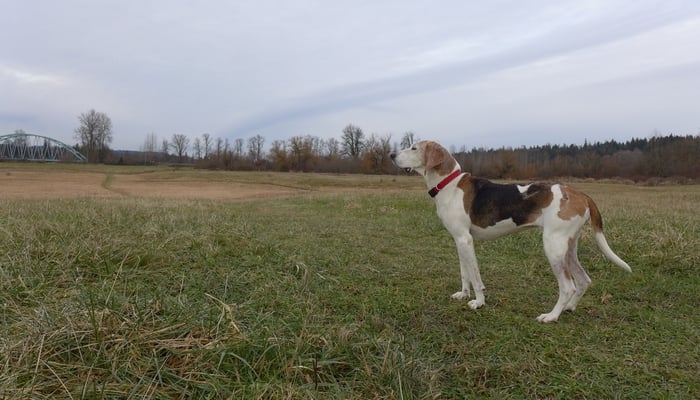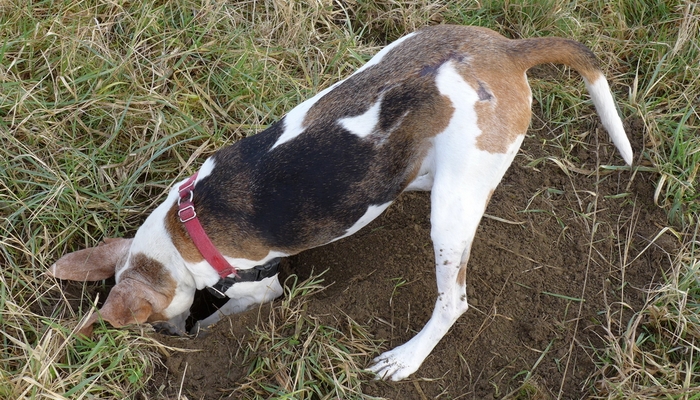Called the people’s choice among coonhounds, the Treeing Walker Coonhound dog combines the best qualities of many coonhound breeds. They are very alert, have amazing endurance, and are very fast. They are also highly intelligent, and are great at the task they were bred for.
Dog Breed Group: Hound Dogs
Height: 20 to 27 inches at the shoulder
Weight: 45 to 80 pounds
Life Span: 10 to 13 years
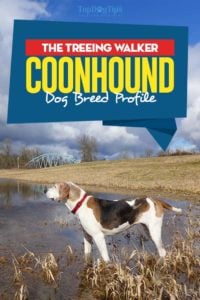 This breed was developed to track and tree wild raccoons and other small animals. According to the American Kennel Club, they are the 122nd most popular breed of dog. The Treeing Walker Coonhound got its name because of its strong ability to track and tree animals. It was bred as a hunting dog, but has also become a popular dog for people who don’t hunt.
This breed was developed to track and tree wild raccoons and other small animals. According to the American Kennel Club, they are the 122nd most popular breed of dog. The Treeing Walker Coonhound got its name because of its strong ability to track and tree animals. It was bred as a hunting dog, but has also become a popular dog for people who don’t hunt.
As with many of the hound breeds, this isn't a dog for the inexperienced owner. Hounds are known to be stubborn dogs that require a trainer who knows the breeds. They're notorious for chasing smaller animals and being difficult to keep in the yard.
If you're considering adopting a Treeing Walker Coonhound dog, this article is a great place to start. It's important that you do your research to make sure you know what you're getting into.
Let's talk a little bit more about the breeds history and common traits. We'll also discuss some of the most common health issues found in Treeing Walker Coonhound dogs.
RELATED: 30 Best Hunting Dogs for All Types of Game and Hunts
Treeing Walker Coonhound Dog Breed Information
History of the Treeing Walker Coonhound
The Treeing Walker Coonhound dog is one of six recognized breeds of coonhounds. They were the 174th breed to be registered by American Kennel Club in 2012. These dogs originated from the Walker Foxhound, which came from the Virginia Hound. The Virginia Hound originated from the early English Foxhounds that came to North America in 1770.
In the 1800s, the Tennessee Lead was crossed into the Walker Hound line. The Tennessee Lead was a dog who was stolen from Tennessee and whose origins were unknown. He had great speed and hunting skills and had a shorter mouth than the English foxhounds from Virginia. The first Walker Hounds were registered as a breed in 1945, and then later given the name of Treeing Walkers.
Hunting
The Treeing Walker dog will track an animal to a tree, and then use its distinctive howl to call their owner over. It is popular as a hunting dog, but can also be a great pet for any active household.
The expression “barking up the wrong tree” originated from the Treeing Walker dog, because of their knack for finding their target (a raccoon, usually), chasing it up a tree, and then barking to tell their owner where to find it. It may also be linked to their tendency to stay with the tree that originally had the prey’s scent on it, even after the animal has moved to another tree.
They have a very distinctive, ringing bark or steady chop that is noticeably different when they have cornered their prey. When hunting these dogs are tireless, intense, and very alert. They have a quick gait with great maneuverability.
MORE INFORMATION: What Are Breaking Scents for Hunting Dogs
Appearance of Treeing Walker Coonhound
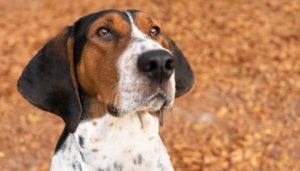 Treeing Walker Coonhounds have a short, dense coat that is smooth and shiny. They normally have a white coat with black spots and some tan markings. They can also sometimes be black with white markings and tan trim, which is referred to as saddle back or blanket back.
Treeing Walker Coonhounds have a short, dense coat that is smooth and shiny. They normally have a white coat with black spots and some tan markings. They can also sometimes be black with white markings and tan trim, which is referred to as saddle back or blanket back.
They are tan and white, but can never be referred to as red, since that might confuse them with the Redbone Coonhound. Treeing Walker dogs look similar to a Basset Hound in some ways, since they both have a square muzzle and long ears.
According to the Official Standard of the Treeing Walker Coonhound dog by the AKC, males measure 22-27 inches and females measure 20-25 inches at the shoulders. They usually weigh 50-70 pounds.
This breed has a muscular body with straight forelegs and it holds its tail high. Treeing Walkers mature slightly more slowly than some other breeds, reaching maturity at 2 years of age. When they’re in good health, they look younger than their age.
Grooming of Treeing Walker Coonhounds
Treeing Walker dogs are quite easy to groom. Their coat requires minimal brushing. Brushing them with a bristle brush, like the one pictured on the left, once a week is sufficient. This will help with shedding as well.
This breed tends to shed moderately, year-round. You should check their long ears regularly as well, since they are prone to developing ear infections. As with any dog breed, you'll need to be sure to trim their nails regularly.
For more information on these specific dog grooming tasks, you can watch one of our short, helpful video guides:
Health of Treeing Walker Coonhound
Treeing Walker dogs are a medium to large breed that has a lifespan of approximately 12-14 years. They have relatively few health issues. Some Treeing Walker dogs may develop hip dysplasia or eye disease, but overall the breed is very healthy.
Hip dysplasia is when the femur doesn’t fit tightly into the hip socket. This can cause a lame leg, pain or arthritis when your dog gets older. Treatment for hip dysplasia can involve pain medication and sometimes surgery.
If used for hunting, be sure to keep your Treeing Walker Coonhound dog up to date on his rabies vaccination. You'll also need to make sure to check him for any scratches or injuries regularly and seek treatment when necessary.
Exercise for Treeing Walker Coonhounds
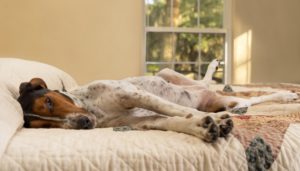 Treeing Walker Coonhound dogs are a highly energetic breed that requires a lot of mental and physical stimulation. This is not a breed of dog to get if you are looking for a very low-maintenance dog who doesn’t need a lot of exercise or long walks.
Treeing Walker Coonhound dogs are a highly energetic breed that requires a lot of mental and physical stimulation. This is not a breed of dog to get if you are looking for a very low-maintenance dog who doesn’t need a lot of exercise or long walks.
They need exercise daily though, and it’s best to give them a fenced in yard where they can run and play without running away. Treeing Walkers are trained to track and hunt, so they do have a tendency to wander when they catch the scent of an animal. This means that keeping them on a leash whenever they’re not in an enclosed area is crucial.
Believe it or not, this breed can sometimes be great climbers.
Be careful with your fencing as well, and be sure they can’t escape it. They are sometimes capable of scaling fences that are over 6 feet tall!
Treeing Walker Coonhounds have extreme endurance and are competitive. They often enjoy games and obstacle courses. Get creative with the activities they do so that they can stay engaged and active. Don't forget to have fun!
Behavior and Personality of Treeing Walker Coonhound
Treeing Walkers are very loyal and affectionate with their family, but can sometimes be apprehensive toward strangers. It is highly recommended that you socialize them with other people and dogs when they are young so that they can be less anxious as adults.
Introduce them to new dogs and people often when they are puppies, and supervise them during these meetings. If you do this when they are young, they should be much better at meeting new people and dogs when they are adults.
Treeing Walkers can get along well with children, especially slightly older children who can treat them gently and respectfully. Again, it’s best to introduce them to children when the dog is young, and supervise those interactions. If a child cannot play gently with them, a Treeing Walker Coonhound dog will not be pleased. They react poorly to roughhousing, often becoming shy and withdrawn.
This breed is very curious and loves being the center of attention once they get to know everyone. They are very sensitive dogs that get attached to their owner. This can sometimes cause them to develop separation anxiety.
Something that can help with this is crate training. Try crating them for a few hours while you’re at home to show them that you always come back for them. They may start to be less anxious when alone if you begin this training. However, be sure to use the crate as a safe training space and not as a punishment.
RELATED VIDEO GUIDE: How To Choose the Right Size Dog Crate
This breed is even more energetic than your average puppy, and they sometimes stand on their hind legs to get a better look at things or to bark at other dogs. They love to nest, and usually enjoy having a crate to retreat to when they’re feeling anxious or just need some time alone. Make sure to have some blankets and/or pillows in their crate, and they will love being there.
Chasing after a Treeing Walker Coonhound dog when they are on a scent may just make them think that you are hunting with them. They will respond by running even faster, so be sure to keep them on a leash when you're not in an enclosed area.
You should work with a professional trainer to teach them to return to you upon command.
Even when Treeing Walkers are well fed, they might hoard food. This can be especially true with bones, as your Walker will probably try to bury them. Another nice thing about this breed is that they drool fairly little. They also tend to eat things they find, and can often open cupboard doors. Be sure to keep anything dangerous out of their reach.
Intelligence of Treeing Walker Coonhound
Treeing Walker Coonhounds are highly intelligent and need intellectual stimulation to be happy and healthy. They respond well to consistent, firm training, and can learn a wide variety of commands.
Try to supply them with toys that can challenge them instead of just simple chew toys. Allow them to entertain themselves with treat dispensing toys, toys with other toys inside of them, or puzzle toys made especially for intelligent dogs. They sometimes use objects to accomplish their goals. They might move objects or furniture to get over a gate, for example.
Because they are so intelligent, Walkers sometimes look for ways to trick their owners, so you need to be very consistent in your training. They often attempt to negotiate, trying an alternate course of action that they prefer instead of what they’ve been told to do. They watch humans closely and can recognize many words.
These dogs can get very attached to certain toys and may steal objects from around the house that attract them. It can help to train them to give back toys upon request or to wait before taking a toy from you. They may sometimes try to steal human food and will become defensive if you try to take it back.
Remember that these dogs respond very poorly to harsh punishment. This will lead to shyness, a lack of trust and anxiousness. If they get bored they may start to destroy things and make lots of noise, so try to keep them intellectually stimulated and make sure they get enough exercise.
How to Train a Treeing Walker Coonhound Dog
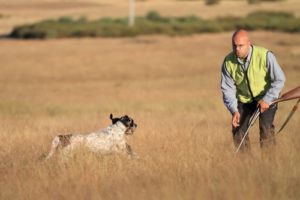 Treeing Walkers are highly intelligent and can learn just about anything if they are trained properly. Be sure to be consistent, firm, and calm with them, and to set rules and boundaries when they’re young.
Treeing Walkers are highly intelligent and can learn just about anything if they are trained properly. Be sure to be consistent, firm, and calm with them, and to set rules and boundaries when they’re young.
They tend to have a short attention span, so keep training sessions short for best results. These dogs are easy to house train and have excellent bladder and bowel control. They like to go on long walks, and prefer to relieve themselves far from their home. They might even try to avoid bowel movements to prolong their walks.
As mentioned above, Treeing Walker dogs do not respond well to punishment or harshness. If you’re harsh to them while training or in general, it may cause your dog to become shy and develop some behavioral issues. They need a great deal of praise and treats while training.
Appropriate Diet
The Treeing Walker dog does not require any special kind of diet. As with all dogs, be sure to choose high quality food and adjust their diet according to their age, development and the amount of exercise they get.
It is best to feed Treeing Walker dogs 2-3 meals per day rather than leaving food down all the time. They tend to eat a lot when they are bored and are prone to weight gain if they are not getting enough exercise.
If they’re going to be hunting you will need to be sure to give them lots of protein and fat. Be sure to discuss this with your veterinarian or a canine nutritionist, as they can help you create a diet that will meet your dog's individual needs. If your Walker is not hunting, they won’t need quite as much fat or protein in their diet.
RECOMMENDED: Understanding Dog Food – Do You Know What's In There?
Who should own a Treeing Walker Dog?
This breed would certainly be best for an experienced dog owner with an active lifestyle who can give them the exercise and stimulation they need. The Treeing Walker Coonhound dog is not ideal for novice owners, since they require a great deal of training and exercise.
Treeing Walkers are not recommended for apartment life either, since they need a lot of space to run around. They also have a high tendency to bark or howl, especially when left alone. It is much better to have them in a house with a fenced-in yard.
If you’re looking for a guard dog, the Treeing Walker dog is not your best choice of breed.
They are very nervous around strangers, but not necessarily loud around them. These dogs get very excited when they catch the scent of any animals. They tend to like older children who can play with them and treat them respectfully, but may not like very young children or kids who tease them or roughhouse with them.
Walkers can be a great addition to an active family who can give them a lot of attention and excitement. Supervise their time with children until they are very comfortable together, and make sure the child is taught to respect the dog. This is a very playful breed that can provide endless entertainment for children and adults alike.
The Treeing Walker Coonhound dog can get along well with other dogs, but might chase smaller animals. They shouldn’t be left alone with any animal other than a dog they are very comfortable with. Any other animal interactions should be carefully introduced to the Walker and highly supervised at all times.
Where to get my Treeing Walker Coonhound dog?
When looking for a Treeing Walker Coonhound dog, try shelters and rescues first. They are not an incredibly common breed, but they do sometimes end up in shelters. If you go through a breeder, be sure to look into the reputation of the breeder and their breeding conditions.
Never buy from a store or person who gets their dogs from a puppy mill. In addition to the horrible conditions at puppy mills that you shouldn’t be supporting, dogs from puppy mills are extremely susceptible to a wide array of diseases and behavioral issues.
READ NEXT: 30 Hunting Dog Supplies That'll Make You A Better Hunter


